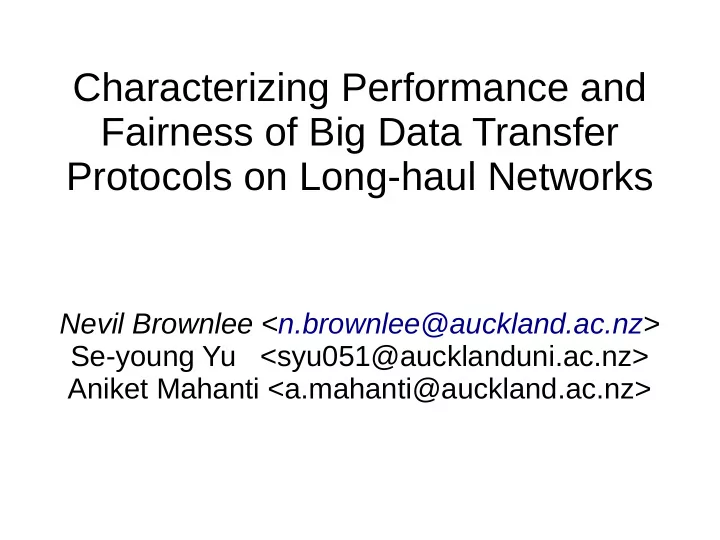

Characterizing Performance and Fairness of Big Data Transfer Protocols on Long-haul Networks Nevil Brownlee <n.brownlee@auckland.ac.nz> Se-young Yu <syu051@aucklanduni.ac.nz> Aniket Mahanti <a.mahanti@auckland.ac.nz>
Transferring over Long Fat pipes ● SKA, LHC, ITER, etc., generate PB of data! ● Transferring data over distance is hard ● TCP is not efficient , UDP is not reliable – TCP uses small buffers by default – UDP doesn't provide congestion control – Neither protocol uses parallel transfer streams ● We tested systems that provide these improvements
Our 'International' Testbed ● 1 0 G b / s , 3 2 0 m s R T T international link ● Tested GridFTP, FDT (TCP-based) and UDT (UDP-based) ● Measured goodput, RTT and bytes in-flight
Disk vs Memory 4 8 GridFTP Disk-Disk FDT Mem-Mem 3 6 Goodput(Gb/s) Goodput (Gb/s) 2 4 1 2 0 0 0 1 2 3 4 5 6 7 8 9 GridFTP FDT UDT Number of flows ● Disk speed limits ● Multiple flows performance improve performance for FDT (which uses ● UDT does not improve TCP) mem-mem transfer rate
What Happens in the Network ● Single Flow ● Five Flows 350 400 Data in transit 250 200 Packet Resends 300 350 250 300 150 200 Bytes in transit (MB) Bytes in transit (MB) 200 250 Packet Resends Packet Resends 100 150 150 200 100 150 50 100 50 100 0 50 0 50 0 0 0 50 100 150 200 0 50 100 150 200 Elapsed Time (s) Elapsed Time (s) (b) FDT (b) FDT ● Multiple flows increase aggregated cwin ● Faster recovery time with multiple flows
Multiple Flows have Side Effects ● Single Flow ● 5 Flows 300 300 RTT (ms) 390 390 Packet Resends 250 250 200 200 Packet Resends Packet Resends RTT (ms) RTT (ms) 350 350 150 150 100 100 330 330 320 320 50 50 310 310 0 0 0 50 100 150 200 0 50 100 150 200 Elapsed Time (s) Elapsed Time (s) (b) FDT (b) FDT ● Plots are for FDT, ● RTT increases for all flows ● More packets are lost GridFTP plots are similar
Recommendation ● Avoid using UDP-based protocol ● Allocate enough socket buffer in OS/Kernel and force applications to use larger socket buffers ● Keep the number of multiple flows low ● Use TCP-based protocol with recent congestion control e.g. CUBIC, Scalable TCP – There are many possible definitions of network “fairness” – We want to use most of the available capacity – We consider our file transfers to be “fair”
Recommend
More recommend